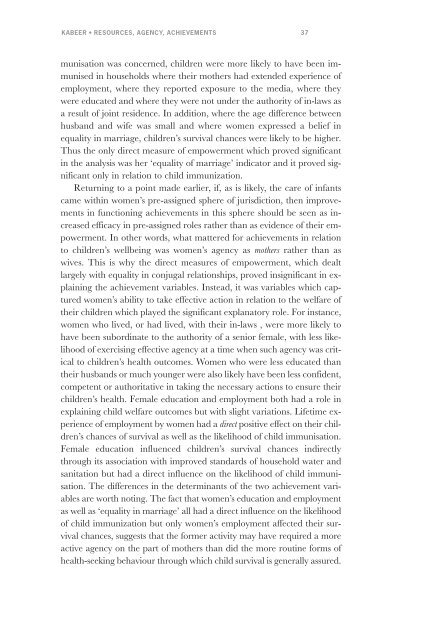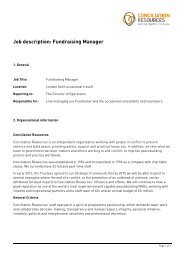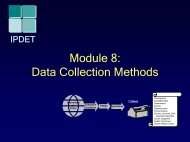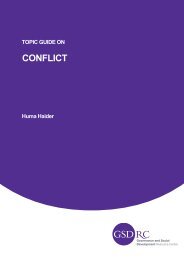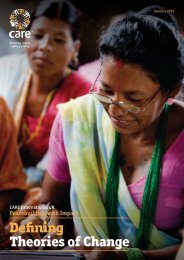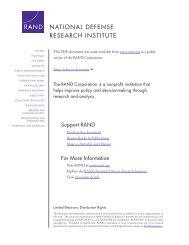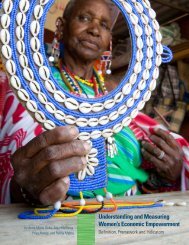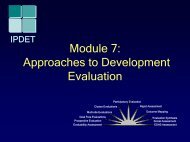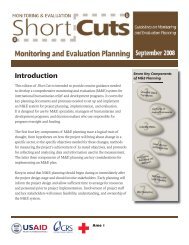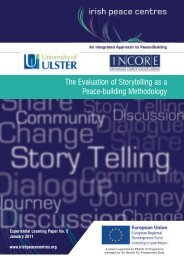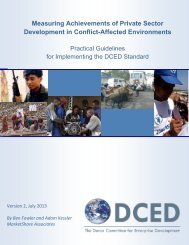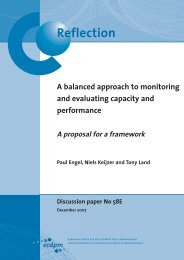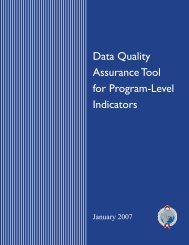Discussing Women's Empowerment - Sida
Discussing Women's Empowerment - Sida
Discussing Women's Empowerment - Sida
Create successful ePaper yourself
Turn your PDF publications into a flip-book with our unique Google optimized e-Paper software.
KABEER • RESOURCES, AGENCY, ACHIEVEMENTS 37<br />
munisation was concerned, children were more likely to have been immunised<br />
in households where their mothers had extended experience of<br />
employment, where they reported exposure to the media, where they<br />
were educated and where they were not under the authority of in-laws as<br />
a result of joint residence. In addition, where the age difference between<br />
husband and wife was small and where women expressed a belief in<br />
equality in marriage, children’s survival chances were likely to be higher.<br />
Thus the only direct measure of empowerment which proved significant<br />
in the analysis was her ‘equality of marriage’ indicator and it proved significant<br />
only in relation to child immunization.<br />
Returning to a point made earlier, if, as is likely, the care of infants<br />
came within women’s pre-assigned sphere of jurisdiction, then improvements<br />
in functioning achievements in this sphere should be seen as increased<br />
efficacy in pre-assigned roles rather than as evidence of their empowerment.<br />
In other words, what mattered for achievements in relation<br />
to children’s wellbeing was women’s agency as mothers rather than as<br />
wives. This is why the direct measures of empowerment, which dealt<br />
largely with equality in conjugal relationships, proved insignificant in explaining<br />
the achievement variables. Instead, it was variables which captured<br />
women’s ability to take effective action in relation to the welfare of<br />
their children which played the significant explanatory role. For instance,<br />
women who lived, or had lived, with their in-laws , were more likely to<br />
have been subordinate to the authority of a senior female, with less likelihood<br />
of exercising effective agency at a time when such agency was critical<br />
to children’s health outcomes. Women who were less educated than<br />
their husbands or much younger were also likely have been less confident,<br />
competent or authoritative in taking the necessary actions to ensure their<br />
children’s health. Female education and employment both had a role in<br />
explaining child welfare outcomes but with slight variations. Lifetime experience<br />
of employment by women had a direct positive effect on their children’s<br />
chances of survival as well as the likelihood of child immunisation.<br />
Female education influenced children’s survival chances indirectly<br />
through its association with improved standards of household water and<br />
sanitation but had a direct influence on the likelihood of child immunisation.<br />
The differences in the determinants of the two achievement variables<br />
are worth noting. The fact that women’s education and employment<br />
as well as ‘equality in marriage’ all had a direct influence on the likelihood<br />
of child immunization but only women’s employment affected their survival<br />
chances, suggests that the former activity may have required a more<br />
active agency on the part of mothers than did the more routine forms of<br />
health-seeking behaviour through which child survival is generally assured.


